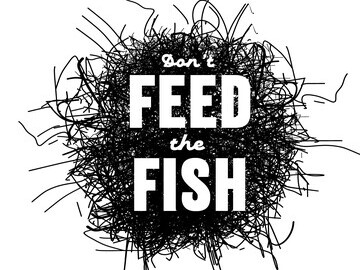Indicators for the prevention of microfibre shedding from apparel found through the Don’t Feed the Fish campaign.
The key learning from this entry level research found UV exposure to be a significant trigger on lowering tenacity in polyester.
Microfibres released from clothes during both the manufacturing and the consumer wash and wear stages, have been found to have detrimental effects environmentally. Initially assumptions from the industry pointed at fleece fabrics as the main contributor, but driven to challenge this deeper within textile engineering, the campaign #DontFeedTheFish was launched in January 2017 to take research to the polymer, fibre and yarn level.
Backed by the industry at the brand, non-profit and supplier levels, detailed research studied polyester yarns in lab conditions under various situations to assess breakage behaviour patterns. Work concluded that UV exposure and yarns of a smaller denier are both considerable factors in lowing tenacity in Polyester.
Don’t Feed The Fish
The #DontFeedTheFish Campaign was launched, to raise awareness at the industry and consumer levels of this unseen, yet hugely impactful issue, whilst raising resources to conduct laboratory-based, controlled research. Industry-based support for this campaign was spearheaded by the European Outdoor Group (EOG) together with key brands including The North Face, Mammut and Finisterre who all recognised the need for a deeper textile engineering understanding of the issue. “Brands have a duty of care to make steps to ensure that the clothing we make is well designed and well made, and mindful of the impact of our sourcing decisions.” said Deborah Luffman, Product Director, Finisterre.
The early support by brands to this work, raised a call to action to other industry brands and retailers in collective support of this challenge. “To solve a problem, you must first understand it,” said Peter Hollenstein, CR Manager, Mummut “The pioneering research performed in the #DontFeedTheFish campaign plays an important role in our industry’s collaborative endeavor to grasp the Microfibre issue in its full complexity and develop effective solutions. As industry interest grew, the work spun out into the Microfibres Consortium Leaders Group headed up by the EOG (http://www.europeanoutdoorgroup.com), of which biov8tion is a key research partner.
Although the industry saw this initially as an issue associated with fibres pulling out of fabrics, #DontFeedTheFish highlighted this as a larger issue, associated also with fibre fragmentation generated by all fabrics of varying constructions, weights and compositions. With a hypothesis substantiated by desk-based research, the work set out to identify what triggers cause fibres to fragment, and how the varying textile production processes can be seen as opportunities to make change within textile engineering and processes longer term.
The work
The work focused on 100% polyester filament samples.
- All samples were sourced from key industry suppliers
- Tenacity was measured on incoming samples and then after 72 hours UV exposure
- A selection of 40 samples were studied
- The effect that differences in yarn specification played on breakage was studied
The results
The key learning from this entry level research found UV exposure to be a significant trigger on lowering tenacity in polyester. A lower tenacity of yarns at the garment level would mean that polyester fabrics are more prone to fibre fragmentation after UV exposure. Such an observation was consistent across the varying yarn specs tested, with up to 42% tenacity reductions after 72hrs UV exposure.
A range of yarn sizes that varied from a 30 to a 150 denier were studied. Results were reviewed as tenacity in g/d and also as force in grams at break (which gives a more realistic representation of the yarn in use in a product). With the force-at-break approach, a consistent sliding scale was seen where the smaller sizes required lower force to break, and larger sizes a higher force to break.
Moving forward
Many other observations were made in regard to recycled content, yarn brightness and supplier processes used, but were deemed inconclusive at this stage, due to relatively small low data sets gathered. Three subsequent pieces of work have since developed from this at both research and industry levels.
- The area of recycled vs virgin raw materials has been taken into a deeper piece of research in order to work towards concluding if virgin or recycled differ in regard to fibre release.
- A correlation of yarn results with corresponding fabric structures is being conducted in order to better understand the interconnection between yarn and fabric construction.
- Work carried out in collaboration with supply chain partners, has been kick-started to look at how these results can be used to support future product solutions at the yarn level.
#DontFeedTheFish has successfully demonstrated a need to elevate research and development from the ground level (polymer) upwards to include fibres, yarns, and subsequent processing stages within the textile industry.
Acknowledgments
This work has been possible through the collective work and support of cross-industry stakeholders and research partners. Thanks goes to:
- Leeds University, Dept. of Colour Science – Prof L. Lin and Dr. L. Jones
- EOG, Finisterre, Mammut and The North Face
- Suppliers that include, but are not exclusive of, Shinkong Taiwan
For more information about #DontFeedTheFish please contact
sophie.mather@biov8tion.com
Press release distributed by Pressat on behalf of Biov8tion Ltd, on Thursday 30 November, 2017. For more information subscribe and follow https://pressat.co.uk/
Microfibres Ocean Pollution Sustainability Textiles Apparel Clothing Environment & Nature Manufacturing, Engineering & Energy
You just read:
Indicators for the prevention of microfibre shedding from apparel found through the Don’t Feed the Fish campaign.
News from this source:



